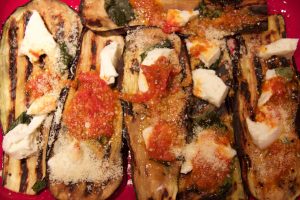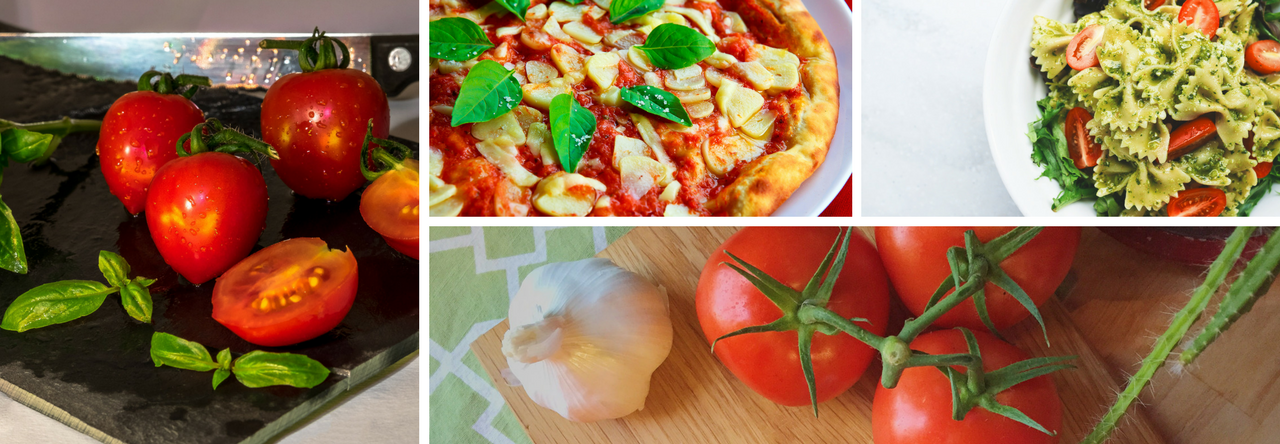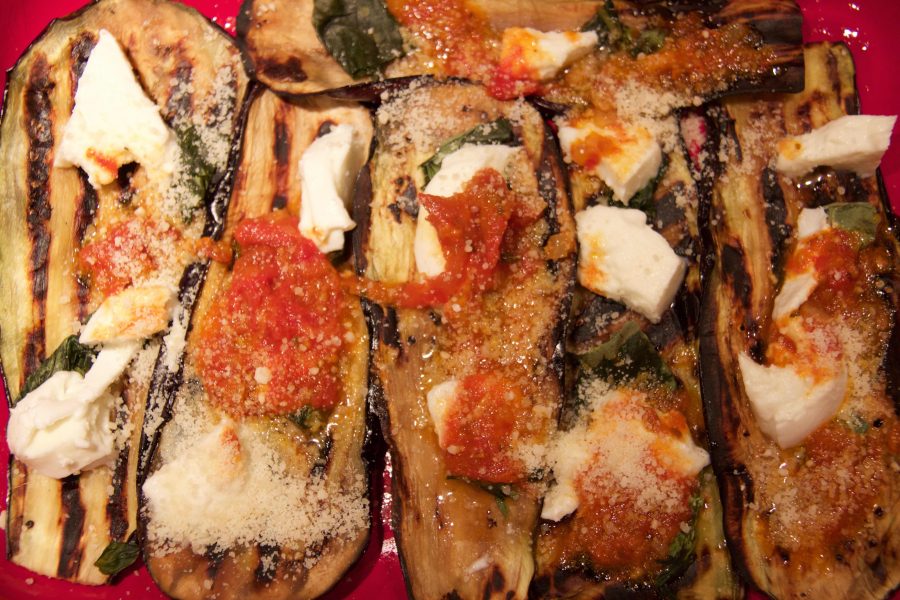I rarely see this wonderful Southern Italian dish on menus in Italian restaurants in the US. But the Parmigiana is one of those “comfort foods” that every Italian knows and loves. I remember coming back home to Calabria from the US one evening after many travel delays. I didn’t get home until after midnight, and everyone was asleep. But my mother had left a Parmigiana covered on the table. It was still warm, and I cut a slice of it and poured myself a glass of wine. My mother came out of her room as I started on my second serving of the Parmigiana, and we talked until very early in the morning.
I’ll never forget how wonderful that Parmigiana was. It tasted like home. A combination of simple flavors that somehow create a complex feeling of warmth and comfort.
If you’ve never had the Parmigiana, I hope this recipe inspires you to add it to your list of favorite recipes.
A general overview – the Parmigiana is sort of like a lasagna, except that the pasta is substituted with grilled slices of eggplant. This recipe requires that you first prepare and grill the eggplant slices: once that work’s done, it’s very easy and fast to assemble the final product.
Ingredients
- Coarse salt
- 2 cups of my simple Italian tomato sauce
- 4 large eggplants (make sure that they are dark purple and unbruised)
- 2 containers of mozzarella cheese (do not use the American version of mozzarella—purchase one that is labelled “Mozzarella from Italy”)
- ½ cup extra-virgin olive oil, divided
- ½ cup freshly grated Parmigiano cheese
- 2 hard boiled eggs, sliced (optional)
- Lots of basil
- Basic tomato sauce
Preparation
- Slice the eggplants lengthwise into long, ¼ inch slices. Because eggplant can sometimes have a slightly bitter, flavor, I like to to salt it so that it sweats out some of the bitterness –some people disagree as they like the bitter flavor, I DO NOT.
- Pour a layer of salt over the eggplant slices, then lay them on top of one another in a large pot. Once you have salted and layered all the eggplant, put another heavy pot on top of the preparation.
- After 20 minutes, remove the eggplant slices and place them in a colander. Rinse the salt very well, and then put the slices on paper towels so that the extra moisture is absorbed.
- Because of the salt that is absorbed in the eggplant (even after rinsing), you will want to be careful of adding any more salt in the preparation of this recipe.
- Place a cast-iron skillet or a grill and turn the heat to very high. As the skillet/grill gets hot, prepare the eggplant slices by using a kitchen brush to apply a thin layer of olive oil to each side. Place them on the hot skillet/grill and cook them until they are slightly scorched on each side.
- When the eggplant slices are ready, remove from the grill with tongs and place them in a single layer on a paper towel, which will absorb any excess olive oil. Add another layer of paper towels to keep the slices separated.
- Once you’ve grilled all the eggplant slices, you are ready to assemble it in the baking pan.
- The assembly of the eggplant parmigiana is similar to that of lasagna: You create layers of the eggplant slices, topped with chopped mozzarella and tomato sauce in a rectangular baking dish (9 x 13 inches).
- Put a small amount of olive oil on the bottom of the dish before adding the first layer of eggplant slices. Make sure the slices overlap slightly as you layer the bottom of the baking dish.

Layers of grilled eggplant with mozzarella, tomato sauce, and a sprinkle of freshly-grated Parmigiano
- Spoon the basic tomato sauce in a thin layer on top of the layered slices.
- Add sliced boiled eggs
- Sprinkle chopped mozzarella over the tomato sauce add basil leafs.
- Sprinkle a small amount of grated Parmigiano over the layer.
- Add the next layer of eggplant slices, topping with the tomato sauce, basil, the mozzarella and grated Parmigiano.
- Create at least 3 layers. The topmost layer should be topped with the tomato sauce, grated Parmigiano, and mozzarella cheese.
- Put a small amount of olive oil on the bottom of the dish before adding the first layer of eggplant slices. Make sure the slices overlap slightly as you layer the bottom of the baking dish.
- Cover with aluminum foil and bake in a preheated oven at 375 F for 30 minutes.
- Enjoy
Comments. My parmigiano is a very simple parmigiano, many in Italy like to add salame, caciocavallo cheese, etc. I like it this way, with lots of basil. The trick for a good parmigiana is to not exaggerate with tomato sauce; just a little bit, the parmigiana should not be swimming in tomato sauce!
Italiano: La “famosa” parmigiana
A me la parmigiana piace semplice, senza salame, senza caciocavallo, solo con mozzarella, molto meglio se di bufala, Parmigiano e un sugo di pomodoro semplice e tanto basilico.
Ingredienti
- Sale grosso
- 1/2 litro della mia semplice salsa di pomodoro italiana
- 4 melanzane grandi (assicurati che siano viola scuro e non ammaccate)
- 2 contenitori di mozzarella (non utilizzare la versione americana della mozzarella, acquistane uno con l’etichetta “Mozzarella from Italy”)
- 120 ml di olio extravergine di oliva, diviso
- 226 grammi di parmigiano grattugiato fresco
- 3 uova sode, affettate (facoltativo)
- Molto basilico
- Salsa di pomodoro simplice, vedere la mia ricetta
Preparazione
- Le melanzane devono essere soffritte su una gratella arroventata; nel forno senz’olio vengono una schifezza, ma per carità, poco, quando le soffriggete pochissimo, olio, perciò uso un pennello per passarglielo sopra.
- Le melanzane vanno tagliate per lungo dello spessore di circa 5 cm. Coprite ogni fetta con un po’ di sale, mettetele una sull’altra, un peso sopra, circa 2 kg, e lasciatele così per 20-30 minuti che caccino la loro acqua amara-c’è chi le preferisce amare, non io di sicuro, e in quel caso potete risparmiarvi questo passaggio, poi sciacquatele bene e asciugatele.
- Poi soffriggetele, come indicato sopra con pochissimo olio su una gratella arroventata –alcuni cuochi, pure famosi, suggeriscono di cuocerle in una pentola antiaderente, non in una graticola, senza olio –a questa gente la patente di cuoco andrebbe tolta!
- Poi dopo avere soffritte in graticola le asciugate con carta assorbente e le mettete in una teglia da forno su cui avrete spalmato poco, pochissimo olio e poco sugo di pomodoro.
- Per il sugo di pomodoro, usate un sugo semplice, tipo quello indicato di sopra. L’importante è metterne poco, cioè le melanzane non devono nuotare nel sugo.
- Poi mettete su ogni strato di melanzane, basilico fresco, tanto; sugo di pomodoro, poco; un po di mozzarella di bufala, diciamo una fetta per fetta di melanzana; e un po’ di rondelle di uovo sodo, e poco Parmigiano.
- Continuate cosi è avrete riempito la teglia e siete arrivati fino all’orlo.
- Coprite l’ultimo strato con più Parmigiano. Poi coprite con carta alumino e mettere nel forno a 375 F. (190 C). Fate andare cosi 20 minuti poi togliete la carta stagnola e rimettete in forno per altri 10 minuti.
- Buon appetito!
Fate la parmigiana come dico io e vedrete come è buona: la mia parmigiana è un piatto leggero per chi vuole stare in forma.



